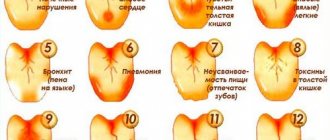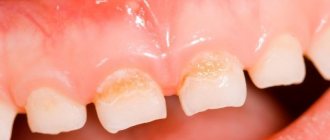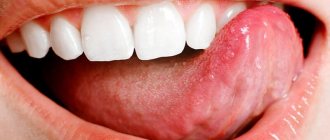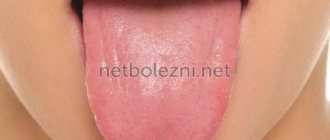Healthy tongue color
A healthy tongue is distinguished by a delicate pink color, and taste buds are evenly distributed over its entire area. The middle fold has clearly defined edges.
Due to the intake of certain foods, drugs and medicines, and all kinds of drinks, the color of the tongue can change. Some give such a reaction due to the specific substances contained in the composition, others simply contain a lot of coloring pigments, which color the tongue and the coating on it in the corresponding color.
There is also a slight dependence of the color of the tongue on the time of year. For example, in summer the tongue becomes redder, and in autumn and winter it becomes slightly yellow.
Therapeutic diet
Regardless of what the cause of the cyanotic organ of taste is, the first thing you need to do is normalize your diet. The following should be excluded from the diet:
- food from fast foods,
- fatty meats (lamb, pork, duck),
- spicy and salty,
- marinades and smoked meats,
- carbonated drinks,
- alcoholic drinks,
- flour and sweet,
- mushrooms.
You need to eat often, but little by little. Make sure that the intestines are emptied in a timely manner. You need to drink at least two liters of still water per day.
The diet menu should include the following products:
- vegetables (except legumes),
- lactic acid,
- vegetarian soups,
- porridge (wheat, rice, buckwheat),
- non-sour fruits and berries,
- dietary meat (rabbit, turkey, chicken breast).
How to identify a disease by the color of your tongue
When making a diagnosis, they rely on a set of signs:
- tongue color in diseases;
- the form of this body;
- oral odor;
- plaque, its color and quantity;
- work of taste buds;
- degree of language functioning.
Another criterion is a change in certain areas of a given organ. But this criterion is very individual and rare. Scientists have hypothesized that the tongue is divided into sections, and each section is associated with a specific organ.
If you need to determine whether the body is healthy or there is some kind of disease, you should examine the tongue only early in the morning on an empty stomach, and rinse your mouth with water before examination. It is best to carry out the inspection in a well-lit room.
What does the color of the tongue mean?
According to the practice of Ayurveda, the color of the tongue eloquently communicates problems with internal organs. Having carried out a competent diagnosis and knowing what color of the tongue is typical for what diseases, you can determine what a person is sick with.
They take into account not only the color of the mucous membrane itself, but also the color of the plaque. An important factor is the amount of plaque, as well as the nature of its distribution over the surface. Based on these signs, you can not only determine the disease itself, but also draw a conclusion about the severity of its course.
Plaque is not always a sign of pathology. It is also present in a person who is completely healthy. The normal color of the tongue is pale pink. And the coating is distinguished by a white or grayish tint, and there is very little of it.
It should not be dense, the pink color should be visible through it. If the surface layer thickens to such an extent that the natural color of the tongue is not even visible and becomes loose, then there is reason to assume the development of a disease.
Gastritis, sore throat, liver disease - all this is revealed by the color of the tongue and the plaque on it. Usually, in the initial stages of disease, the plaque is white. Worsening of the disease causes a change from white to gray. This means that the symptoms are intensifying, and they will intensify in direct proportion to the darkening of the plaque.
White
White color is a sign of fungal infections in the body - thrush, as well as acute respiratory viral infections, influenza. It may indicate a lack of water in the body. Also, a coating of this color appears with quite serious diseases of the gastrointestinal tract - gastritis, ulcers, stomach cancer.
Hypovitaminosis is also characterized by a whitish coating.
Gray color
Gray plaque usually also indicates problems with the stomach or gastrointestinal tract. A person who has such a plaque may develop a stomach ulcer (in this case, the white plaque is combined with hunger pains), chronic gastritis (complemented by heaviness in the stomach).
Yellow color
The color of the tongue in case of gallbladder diseases is no longer white, but yellow. There is a possibility of bile accumulation in the body; it is necessary to check the correct functioning of the liver.
A yellowish coating is characteristic of acute pancreatitis and gastritis. The yellow color of the tongue is typical in hepatitis and cirrhosis of the liver.
Less serious causes of yellow plaque include bacterial and fungal infections.
A dirty yellow tongue is usually found in heavy smokers.
Green color
Another symptom, but of a different disease, will be a green tongue.
The most common diagnosis, which gives a green tongue as one of the symptoms, is the improper functioning of the gastrointestinal tract, in particular the duodenum.
In certain cases, this color of the tongue appears when there is a problem with the gallbladder, for example, when there is insufficient outflow of bile.
Dark, black color
There are times when the tongue becomes dark and even black. This is a likely indicator of a disease such as acidosis. Acidosis is dehydration associated with problems in the pancreas.
A tongue that is too dark also warns of the development of chronic diseases.
A black tongue indicates abscesses, problems with the spleen, or severe viral infections in the body. In rare cases, a black tongue is a sign of Crohn's disease.
Blue color
A bluish tongue is a sign of lung disease. A blue tongue may indicate problems with the kidneys.
A blue or dark gray tongue indicates abdominal diseases, in particular, a purulent abscess of the abdominal cavity. If, in addition to the strange color of the tongue, there are symptoms such as abdominal pain, fluctuations in body temperature, then it is best to call a doctor or go to the hospital.
Brown
A brown tongue may indicate bleeding in the mouth. When plaque of this color appears, diseases of the liver, gallbladder, and pancreas are often diagnosed.
A brown tongue is typical for heavy smokers.
Iodine-containing preparations also provoke the appearance of a brown coating on the tongue.
Of red color
Red color is a clear sign of infection or inflammatory process.
A red tongue, for example, is characteristic of feverish colds accompanied by high fever. Inflammation can occur in the gastrointestinal tract and lungs. A dry red tongue is a symptom of inflammation of the gray matter of the brain.
A rich red color can also indicate blood diseases or problems with the cardiovascular system.
Allergy manifests itself in the form of an uneven red color of the tongue.
Raspberry color
By adding a crimson hue to the red color, a specialist can diagnose a sore throat, scarlet fever or pneumonia. Moreover, with scarlet fever, the tongue becomes shiny and smooth, the papillae become less pronounced.
Raspberry tongue is a specific symptom of Kawasaki disease, which causes complications on the heart.
Dark red color
The burgundy color of the tongue appears in diseases of an infectious nature. Moreover, the darker the tongue, the more pronounced the disease. The tongue also becomes dark red in case of serious kidney diseases and intoxication of the body.
Purple color
Purple color indicates heart problems and poor circulation, lack of nutrients, high cholesterol and tongue injury.
The purple color of the tongue indicates weak immunity due to chronic diseases, in particular such as diabetes, AIDS; digestive problems, Raynaud's disease, blood clots.
Colorless
A light-colored tongue may indicate a lack of vitamins in the body, anemia.
Purple tongue on a person or under it - photos, causes, treatment
Purple tongue
Purple color of the tongue in humans is a fairly common health problem, although it is not as common as the formation of white, yellow or black coating on the tongue.
Purple tongue is more common in animals, but it is not only a problem for dogs or cats, but also for people.
In addition to being completely purple, your tongue can have shades including red-violet, dark purple, black-violet, blue-violet, etc. These color changes can be seen on the underside (including bluish or purple veins), on the back, and even on the tip of the tongue.
This phenomenon can be observed not only in adults, but also in children of different ages, including infants. So your age doesn't really matter.
Associated symptoms
If your tongue is purple, then depending on the reasons, some other symptoms may appear.
The most common:
- tongue soreness;
- swelling;
- discharge;
- tubercles, growths, pimples;
- sores and cracks.
Causes
What makes a tongue purple? A change in the normal (pink) color of the tongue to violet or purple (uniform or patchy) can be due to a large number of reasons. Let's look at a number of the most common ones.
Circulatory disorders
The first possible reason for the purple coloration of the tongue is impaired blood circulation.
Occurs as a result:
- heart disease;
- peripheral arterial diseases, in particular Raynaud's disease;
- thrombosis;
- varicose veins;
- diabetes;
- obesity, etc.
In this case, other signs of the disease appear, for example, numbness, pain, muscle cramps, a burning sensation and pain in the legs that passes during walking, as well as tingling in various parts of the body.
Nutrient deficiency
Lack of vitamins is another common cause of a purple tongue. Most often, it indicates a deficiency of riboflavin (vitamin B2). However, this is not the most important sign of ariboflavinosis (a disease that occurs due to a lack of this vitamin).
If you have this condition, you are likely to have other symptoms:
- stomatitis (inflammatory changes in the oral mucosa);
- soreness and redness of the tongue;
- pharyngitis, sore throat;
- cracks on the lips.
Also, deficiency of vitamin B12 and folic acid can cause the tongue to change color to reddish-purple.
If the discoloration is due to poor nutrition, make sure you eat enough foods rich in these vitamins.
In particular:
- eggs;
- meat;
- fish;
- hard cheeses;
- green leafy vegetables;
- fermented milk products (yogurt, sour cream, cottage cheese).
Respiratory diseases
Diseases of the respiratory system that affect the supply of oxygen to the blood can cause the tongue to appear purple, especially dark purple or bluish. This is accompanied by the appearance of a bluish-purple tint to the skin and veins.
The presence of symptoms increases the likelihood that the problem is respiratory related:
- wheezing (audible at a distance or heard by a doctor);
- feeling of lack of air (shortness of breath);
- “a persistent cough that produces mucus (phlegm)” [nhs.uk];
- frequent colds or exacerbations of diseases of the bronchi and lungs with increased body temperature.
High cholesterol
Many naturopaths associate the problem of purple tongue with high cholesterol levels. This sign of a disorder in lipid (fat) metabolism in the body is often the cause of heart disease and deterioration of general blood circulation.
Injury
Serious trauma, including tongue biting or piercing, can cause purple discoloration. In this case, you will have an inflamed, swollen, painful purple tongue.
Other reasons:
- disorders of the digestive system;
- weakening of the drainage (cleansing) function of the lymphatic system,
- pathology of blood vessels;
- a weak immune system, especially in people with diseases such as AIDS or severe, untreated diabetes;
- nutritional problems: pellagra (lack of vitamin PP), sprue (deficiency of vitamin B12 caused by intestinal diseases) and pernicious B12-deficiency anemia, Plummer-Vinson syndrome (pathology of the digestive organs due to iron deficiency) - will cause a reddish shade of purple;
- long-term use of certain medications (most often antibiotics), allergic reaction to any food or medications;
- the consumption of certain fruits and vegetables, such as beets, grapes, pomegranates, as well as products with coloring additives (chewing gum, sweets, juices) lead to a temporary change in the color of the tongue;
- accumulation of food debris in the oral cavity (on the gums, near the teeth), and the growth of bacteria;
- smoking (not only the tongue, but also the lips can change color);
- long-term inflammatory processes in the tongue.
Reason in Chinese traditional medicine
According to Chinese medicine experts, the presence of a purple tongue may indicate either excessive heat and decreased fluid (i.e., internal dryness) in the body (due to increased heat production), or a so-called cold condition, which causes “stagnation of blood.” poor circulation, elevated sugar levels, leaving you feeling tired and cold inside.”[dailymail.co.uk]. A likely cause of this problem may be the consumption of cooling (mainly Yin) foods. You should make sure you have warming (yang) ingredients in your diet, such as ginger, coriander, cinnamon and horseradish.
Chinese Medicine Basics Regarding Purple Tongue:
- If you have a greenish or bluish-purple or light purple tongue, there is probably stagnation of blood in the body and internal cold prevails in the body.
- A dark reddish-purple color indicates that your body is losing fluid (internal dryness) due to excessive heat, and your body is stagnating due to internal heat.
- A light purple hue indicates that you probably have a dominant internal wind.
There are many other diseases and syndromes that can cause a purple tongue. It is important to consult a qualified doctor in time, who will not only make the correct diagnosis, but also prescribe adequate treatment.
In children
The color of the tongue changes more often in younger children, much less often in children 10-12 years old.
If your baby has a purple (including dark purple or just patchy) tongue, which may be seen on the side or under the tongue, you probably don't need to worry as it may be the result of tongue biting (and rubbing), especially during teething.
Check for bruises, cracks and other damage. It is worth remembering that such a problem may indicate a congenital pathology, lack of oxygen supply, the presence of infection, etc.
Purple spots and pimples - causes
Purple pimples on tongue
You may experience either a complete purple staining of your tongue or individual spots (for example, in the form of a purple flap). The spots may be found on the side, under the tongue, on the tip and/or back. What are the main causes of purple spots on the tongue?
Acute swelling of the tongue
This condition causes a swollen tongue that quickly increases in size (it can block the airways), with large purple spots.
More common in adolescents and young children, it is usually a manifestation of an acute allergic reaction, and in some cases is life-threatening. It is important to quickly provide the necessary emergency assistance.
And in the future, establish the cause and treat with specific drugs that reduce the body’s ability to such reactions.
Traumatic injuries
Spots and pimples on the tongue can be the result of damage due to trauma, for example, when biting your own tongue, after piercing or using certain dental instruments.
In addition, such lesions can be the result of Kaposi's sarcoma (a certain type of malignant tumor), purpura (a spotty-bruised rash on the mucous membranes and skin due to a clotting disorder and the release of blood elements from the capillaries), hemangiomas (benign vascular tumors), bacterial and viral infections.
Other reasons
The causes of purple dots, including under the tongue, can be:
- allergic reactions;
- coloring food products;
- insufficient supply of the body with vitamins;
- aphthous stomatitis (inflammation of the oral mucosa with the formation of ulcers);
- chronic stress overexertion.
Spots and visible veins under the tongue
Staining of the lower surface of the tongue is the most common situation.
The presence of a purple color in this area, including spots, pimples and bluish veins, may indicate a number of infectious and non-infectious pathological processes.
The spots may be dark purple, black or dark purple. They may be the end of blood vessels (which is normal) or blood clots.
The most common pathological causes:
- mechanical damage and injury;
- inflammation of the salivary glands;
- vitamin B12 deficiency;
- smoking;
- weak immunity (for example, in people suffering from HIV);
- infections (bacterial and viral, including aphthous stomatitis and herpetic lesions);
- excessive anxiety and tension;
- changes in hormonal levels.
Many people who have a dark purple tongue often fear that it could be a sign of oral or salivary gland cancer. This diagnosis is extremely doubtful, in the absence of additional warning symptoms.
Manifestations that increase the likelihood of a malignant tumor:
- reddish, bluish or purple areas against the background of the overall purple color of the tongue;
- ulcerative defects, painful and painless, not healing for a long time;
- numbness in the mouth;
- constant pain in the throat or tongue;
- difficulty chewing and swallowing food.
If these symptoms are absent, then it is unlikely to be cancer. If any of the above bothers you, you need to consult a doctor - a therapist, a dentist, an ENT specialist (otolaryngologist).
To avoid purple staining of the underside of the tongue, it is necessary to maintain good oral hygiene. In addition to regular brushing of your teeth and tongue, you can use rinsing your mouth with a saline solution (0.5 tsp salt (preferably sea salt) per 200 ml of warm water), as well as antiseptic preparations sold in pharmacies (if there is damage to the mucous membrane).
However, it is necessary to act not only on the altered tongue, but also to treat the underlying disease or correct the pathological condition (for example, a hormonal profile or a lack of nutrients in the diet).
Visible veins under the tongue
Purple veins under the tongue
Sometimes the purple underside of the tongue is caused by visible purple veins. There is nothing wrong, it is normal as long as the veins are not swollen and/or painful.
The sublingual veins tend to turn dark purple, blue, or blackish-purple if there is a reduced amount of blood flowing to the area.
This problem can occur at any age, including infants and older adults.
However, dilated, large, thick and clearly visible purple veins under the tongue under the tongue most likely indicate another disease - varicose veins. The manifestation of this pathology can even be on the tongue.
When should you see a doctor?
If the discoloration and violet or purple coloration of the tongue is associated with circulatory problems, as in the case of respiratory diseases, or is accompanied by life-threatening symptoms (shortness of breath, chills, tingling or tightness in the chest, etc.), you should immediately consult a doctor to establish a diagnosis and timely treatment.
If the purple coloration of the tongue persists for several weeks, you also need to consult a doctor, regardless of whether there are other general or local changes.
Loading…
Source: https://100simptomov.ru/rotovaya-polost/yazyk/fioletovyj-yazyk-ili-pod-nim
Associated symptoms
In addition to changes in the color of the tongue, various diseases may cause changes in the structure of the tongue, taste sensations, shape, etc.
Changing shape
If the fold of the tongue is bent, then these changes may indicate cervical osteochondrosis. Most often it develops due to lack of mobility and a sedentary lifestyle.
If the fold changes its shape in the middle of the tongue, then this may indicate lumbar osteochondrosis. This disease is widespread among drivers.
Stains
If the tip of the tongue begins to turn red, this may indicate prerequisites for the development of coronary artery disease.
If redness occurs along the edges of the tongue, this indicates problems with the lungs. Most often found in smokers.
White and red spots on the surface of the tongue are signs of scarlet fever.
Raid
The formation of plaque at the base of the tongue can indicate a variety of diseases, depending on its color. These diseases include liver disease, kidney disease, colds, as well as rare diseases such as Crohn's disease.
Texture changes
If teeth marks remain on the tongue, this may indicate dysbacteriosis and an excess of toxins. It is necessary to change the diet.
Cracks
The formation of cracks in the tongue indicates diseases of the blood or endocrine system. If these signs are detected, it is best to go to the hospital and undergo a general examination.
Deep and painful cracks across the entire tongue indicate vascular disorders in the brain.
Change in taste sensations
A change in taste sensations in any part of the tongue may indicate a malfunction in the body. Disabling the taste buds of the tongue indicates problems with the nervous and endocrine systems.
Tongue deviation to the side
Deviations of the tongue in various directions indicate disruption of the cerebral cortex and ischemic stroke.
Ulcers
Small ulcers over the entire area of the tongue can be a sign of tuberculosis in humans.
Smell
Bad breath may indicate diseases of the gastrointestinal tract or dental problems.
Tubercles at the base
Pronounced tubercles at the base of the tongue may be enlarged papillae, due to allergies and ingestion of spicy food - this is not dangerous.
Red bumps are a sign of the dangerous and rare Kawasaki disease, which occurs in young children, and white bumps can be a symptom of oral cancer.
Reason in Chinese traditional medicine
According to Chinese medicine experts, the presence of a purple tongue may indicate either excessive heat and decreased fluid (i.e., internal dryness) in the body (due to increased heat production), or a so-called cold condition, which causes “stagnation of blood.” poor circulation, elevated sugar levels, leaving you feeling tired and cold inside.”[dailymail.co.uk]. A likely cause of this problem may be the consumption of cooling (mainly Yin) foods. You should make sure you have warming (yang) ingredients in your diet, such as ginger, coriander, cinnamon and horseradish.
Chinese Medicine Basics Regarding Purple Tongue:
- If you have a greenish or bluish-purple or light purple tongue, there is probably stagnation of blood in the body and internal cold prevails in the body.
- A dark reddish-purple color indicates that your body is losing fluid (internal dryness) due to excessive heat, and your body is stagnating due to internal heat.
- A light purple hue indicates that you probably have a dominant internal wind.
There are many other diseases and syndromes that can cause a purple tongue. It is important to consult a qualified doctor in time, who will not only make the correct diagnosis, but also prescribe adequate treatment.
Tongue color in diseases
Some diseases are clearly diagnosed by the color of the tongue.
For gastritis
With gastritis, a thick gray coating forms on the tongue. This color of plaque appears already in the chronic stage of the disease.
Plaque with gastritis forms on the entire surface of the tongue. There is an unpleasant sour taste in the mouth. The oral cavity either suffers from increased dryness or from excessive salivation.
For appendicitis
With appendicitis, the tongue becomes covered with a thick layer of white plaque. Also, the tongue suddenly becomes very dry, the coating turns into a crust. The entire oral cavity becomes very dry, including the lips.
For liver disease
With liver disease, the first thing to do is change the color of the tongue. Typically it turns yellow. This happens due to too much bile in the liver.
For stomach cancer
With stomach cancer, most patients experience a change in the color of the tongue. A large layer of gray plaque forms on the tongue. Moreover, plaque accumulates unevenly on the surface of the tongue, and the main place of its concentration is the middle of the tongue and its tip.
For Crohn's disease
With Crohn's disease, the tongue becomes covered with a black coating. This is due to a decrease in the amount of adrenal hormones in the body. As a result, the skin produces large amounts of melanin.
Black spots of different sizes and shapes form on the tongue. When brushing your tongue, its color does not change. You can get rid of black spots only by getting rid of the root cause.
Ways to clean your tongue
To clean your tongue from plaque, a regular toothbrush will do. It can even be without a special rough lining, which is designed to care for the tongue. You can do without it. It is enough to take a medium-hard brush and walk the bristles from the root of the tongue to the lips, using antibacterial paste.
READ ALSO: Rough tongue: causes and solutions You can use a scraper specially designed for this purpose as a device for cleaning the tongue. It can be plastic, wood or metal. Some specimens also have special brushes. Tongue hygiene procedures should be carried out immediately after brushing your teeth. You need to move the scraper from the root of the tongue, gradually moving towards its end. First, the side with the brush is used, and then its hard side is used, with the help of which the tongue is massaged.
If you don’t have a brush or scraper at hand, you can use, for example, a teaspoon, a bandage wrapped around your finger, a clean towel or a textile napkin.
If after these procedures the plaque appears again, you can try the following traditional methods:
- Rinse your mouth with herbal infusions, which normalize the microflora in the mouth and eliminate the causes of plaque (we recommend reading: white coating on the tongue: causes, photos and treatment). To do this, you need to pour boiling water over the herbs (chamomile, mint, sage, calendula, oak bark) and leave for about an hour.
- Every morning before meals, take a decoction of flaxseed, which has a positive effect on digestion.
- Rinse your mouth with vegetable oil three times a day. The procedure must be done for at least 20 minutes and then spat out. One spoon of oil will be enough. After this, the mouth should be rinsed with water.
Map of diseases of internal organs by language
Scientists believe that the tip of the tongue is connected to the heart, the central part - to the stomach and pancreas, the back part - to the kidneys, the right lobe of the tongue - to the spleen and right lung, the left - to the liver and left lung. If strong changes occur in any area, it means there are problems with one or another organ.
This map will help you identify tongue disease by color and location.
Redness:
- at the base - impaired renal function;
- in the middle - diseases of the colon;
- at the tip - problems with the cardiovascular system;
- front part - weak lungs, breathing problems;
- the central part is stomach diseases.
Small cracks located throughout the entire area of the mucosa appear with intestinal diseases.
Changes in the fold in the middle of the organ:
- transformation of shape - problems with the spinal column;
- deviation of the fold to the right - back pain;
- deviation to the left – displacement of the cervical vertebrae;
Trembling in the tongue may indicate severe stress or a disorder of the nervous system.
When diagnosing diseases by the color of the tongue, additional symptoms should be taken into account, since the same shade of the tongue characterizes both problems that do not require serious intervention and diseases that require immediate hospitalization.











